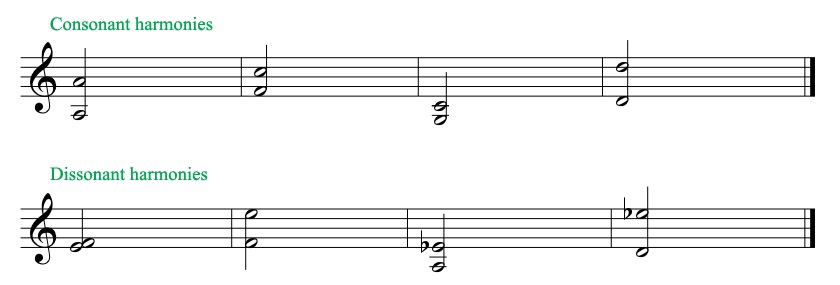Notes that sound good together when played at the same time are called consonant. Chords built only of consonances sound pleasant and “stable” you can listen to one for a long time without feeling that the music needs to change to a different chord. Notes that are dissonant can sound harsh or unpleasant when played at the same time. Or they may simply feel “unstable” if you hear a chord with a dissonance in it, you may feel that the music is pulling you towards the chord that resolves the dissonance. Obviously, what seems pleasant or unpleasant is partly a matter of opinion.
Of course, if there are problems with tuning, the notes will not sound good together, but this is not what consonance and dissonance are about.
Consonance and dissonance refer to intervals and chords.
An interval is measured between two notes. When there are more than two notes sounding at the same time, that’s a chord.
Simple intervals in modern Western music are considered to be pleasing to the ear.
Chords that contain only these intervals are considered to be “stable”, restful chords that don’t need to be resolved. When we hear them, we don’t feel a need for them to go to other chords.
Intervals that are dissonant are considered to be somewhat unpleasant or tension-producing. In tonal music, chords containing dissonances are considered “unstable” when we hear them, we expect them to move on to a more stable chord. Moving from a dissonance to the consonance that is expected to follow it is called resolution, or resolving the dissonance. The pattern of tension and release created by resolved dissonances is part of what makes a piece of music exciting and interesting. Music that contains no dissonances can tend to seem simplistic or boring. On the other hand, music that contains a lot of dissonances that are never resolved (for example, much of twentieth-century “classical” or “art” music) can be difficult for some people to listen to, because of the unreleased tension.
In most music a dissonance will resolve; it will be followed by a consonant chord that it naturally leads to.
What kind of spiritual lesson is in this for the body of Christ ? What is God’s perspective ?
We talk about unity. A lot of people believe that means we all need to be the same, or in unison, playing the same notes. And yet, God’s word says that the body is made up of different parts. So we come to realize that we need all the unique purposes of each part, working together. (1 Corinthians 12:4-11) We can’t say to one part, “I don’t need you”. (1 Corinthians 12:12-26)
Those who have the wrong perspective of what unity is intended by the Father to look like, (John 17; the prayer of Jesus to make us one just as He and the Father are one) might say, “What we need is harmony”. Their concept is that everything should flow together in our body, going along in perfect harmony, which in the music theory lesson above is what’s described as “consonance”. (Romans 12:16-21) While it is good and sounds good, even here in this passage of scripture we can see that we are to treat our enemies with love, and to bless those who persecute us. This shows that in the written songs of life there will be times when dissonance appears. If it never appeared in the music of life, there would be no room for being truthful in relationships, should that truthfulness cause “dissonance”. In other words we would totally avoid anything that seemed unpleasant, just to get along. That’s false unity, and false peace. It takes time for every one of us to grow up into the likeness of Christ. It may be pleasant or more palatable for awhile, but without correction, rebuke, or exhortation (dissonance) that calls us to come into perfect alignment and harmony (consonance) with the word of God, you will settle for the lies of the enemy. (Hebrews 12:7-11) God wants us to learn to be comfortable with being uncomfortable, so when things seem to feel unstable (dissonant), we will recognize that even the trials, temptations, and challenges are all there to teach us to be drawn back to the stable heart of God. He is never rattled by anything, and He wants us to see that He turns all things for our good, if we will only believe it. He brings us back to the consonance with a much greater appreciation for it, for our fellow musicians, and especially Him as our great conductor.
Of course if you’re chords (relationships within the body) are overwhelmingly dissonant, and not resolved with consonance, their will be an unpleasant ending. We all must have our eyes and focus on the conductor. God expects us to work through the tactics of the enemy, by getting beyond his loud clanging methods, to see the precious people who don’t have their instruments fine tuned yet. We will find that this fine tuning is a process in each one of us, so we extend mercy to our fellow orchestra members.
Growing up into the mature bride of Christ as His body of believers will mean that the entire musical score will have intervals of both consonance and dissonance chords. If we only have the consonances, we will be content to just stay there, not realizing that God is calling us to the deeper, fuller, and richer tones. We learn and don’t become stagnant when conflict of dissonance comes. He then teaches us how to grow into the resolution, back to the consonance. It will all flow together and become God’s song of deliverance over us, teaching us to operate in the sounds of heaven.

